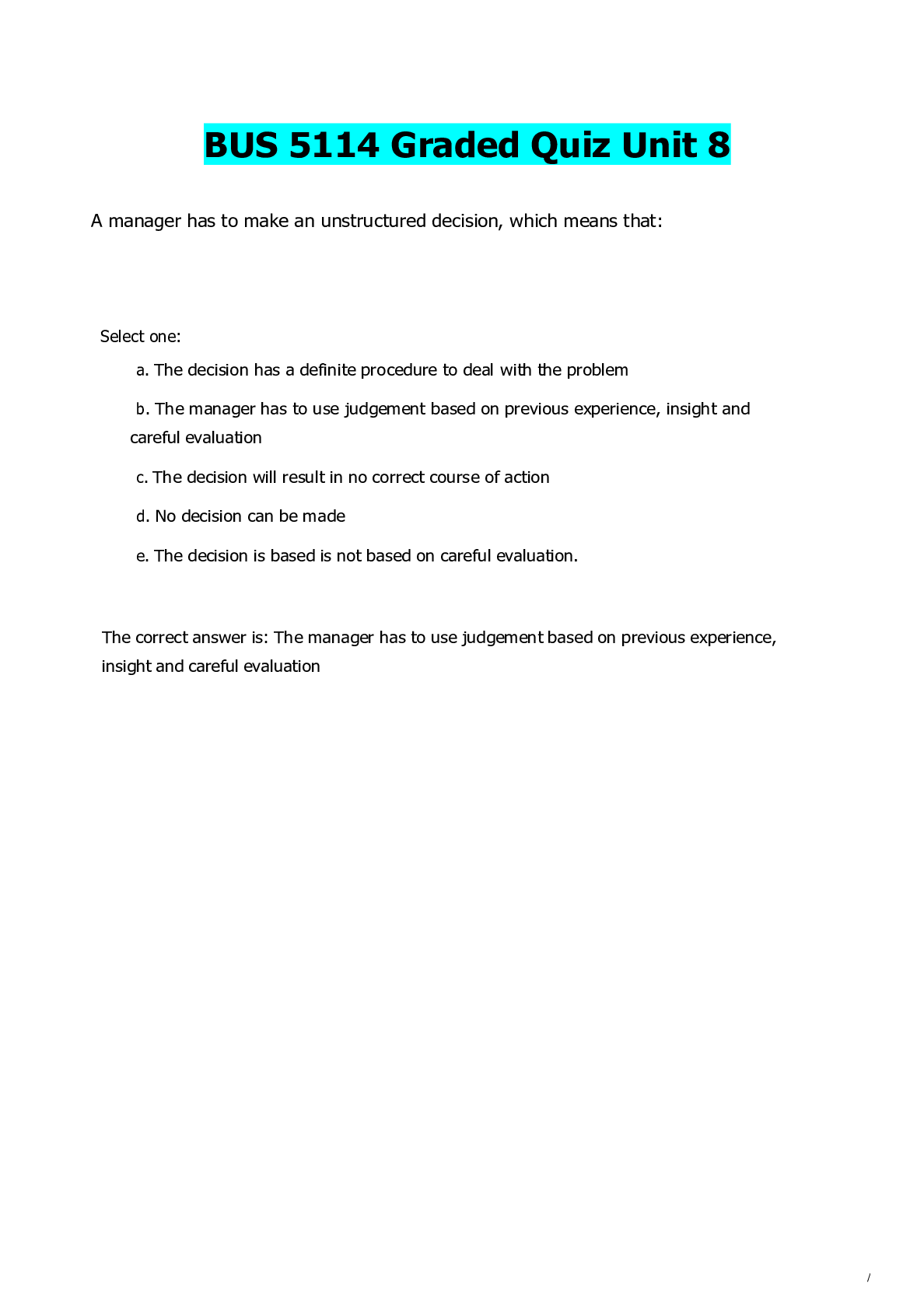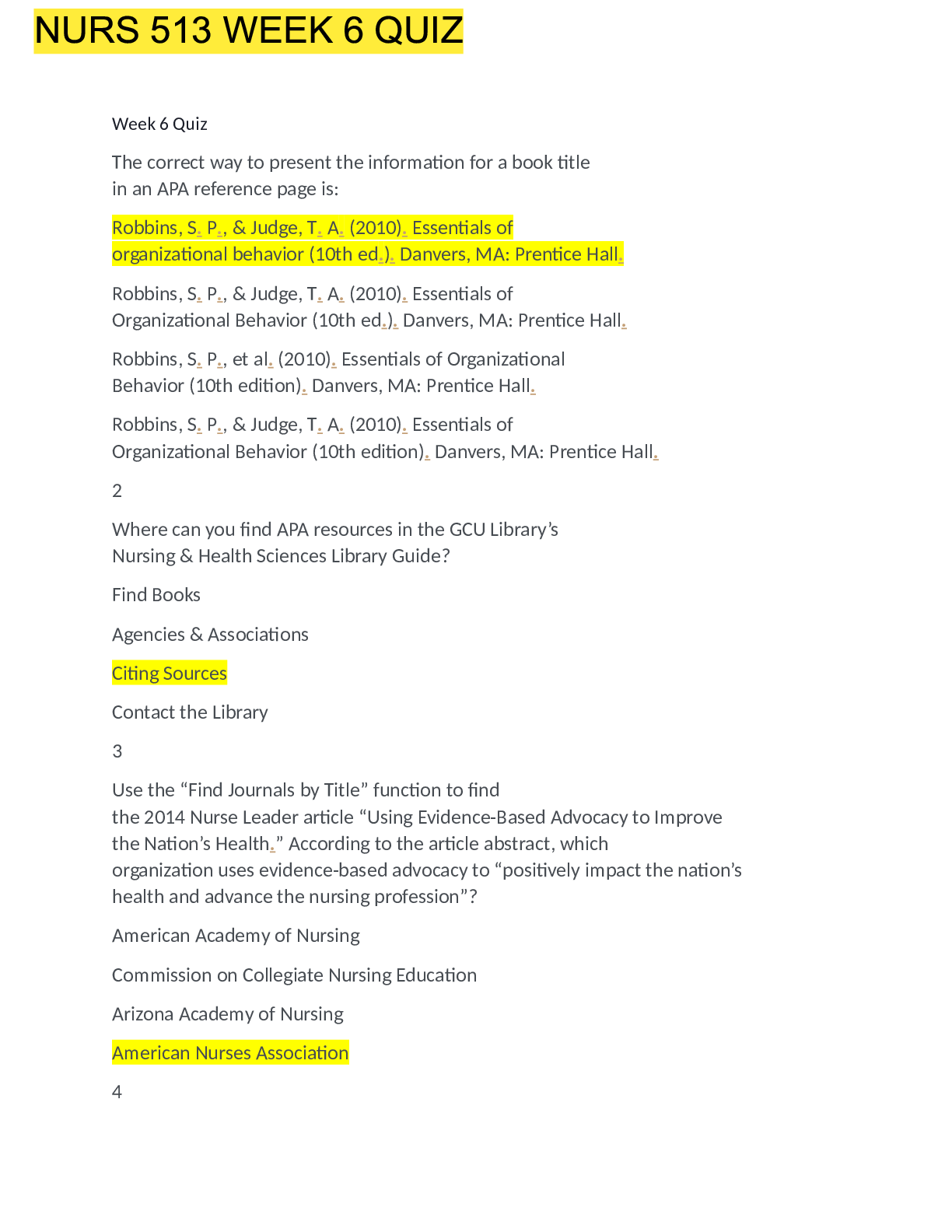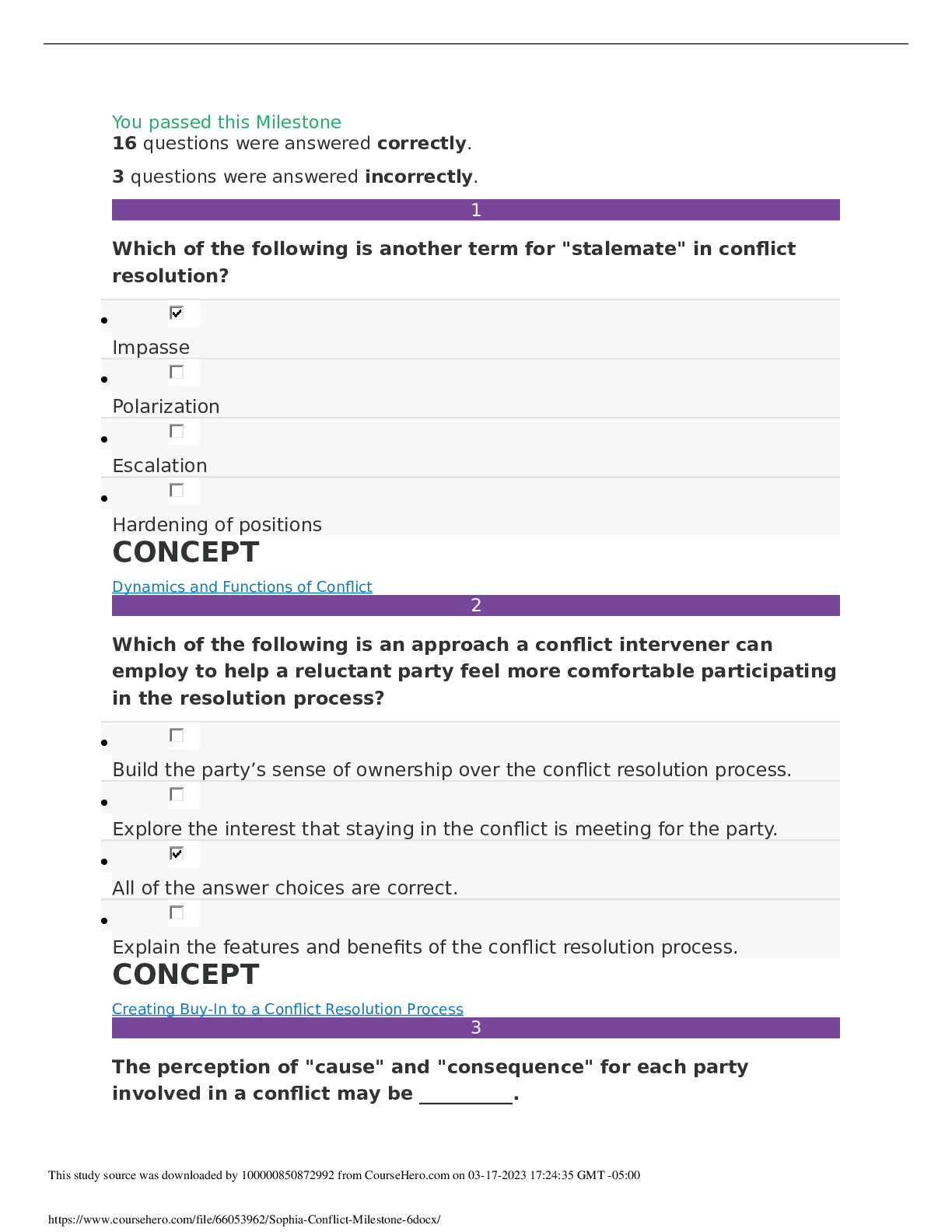*NURSING > EXAM > NURS-6501N Week 3, Advanced Pathophysiology_ WALDEN UNIVERSITY: QUESTION AND ANSWERS RATED A (All)
NURS-6501N Week 3, Advanced Pathophysiology_ WALDEN UNIVERSITY: QUESTION AND ANSWERS RATED A
Document Content and Description Below
• NURS-6501N-Quiz Wk3 • Question 1 0 out of 0 points When completing this quiz, did you comply with Walden University’s Code of Conduct including the expectations for academic integrity? ... • Question 2 1 out of 1 points A child presents to his primary care provider with disorientation, delirium, aggressiveness, and stupor. His parents report that he was recently ill with an upper respiratory infection, which they treated with aspirin. Which of the following is the most likely diagnosis? • Question 3 1 out of 1 points An older adult is admitted to the ER following a fall. The patient complains of pain in the back. The patient has a history of osteoporosis. The nurse would expect the patient’s injury and subsequent pain is most likely due to: • Question 4 1 out of 1 points A patient with an addiction to alcohol checked into a rehabilitation center. He experiences delirium, inability to concentrate, and is easily distracted. From which of the following is he most likely suffering? • Question 5 1 out of 1 points When a patient has a fever, which of the following thermoregulatory mechanisms is activated? • Question 6 1 out of 1 points A 20-year-old male was at the supermarket when he fell to the ground. Bystanders reported that he lost consciousness and his body tensed up then relaxed, then tensed and relaxed several times. He most likely was experiencing a(n): • Question 7 1 out of 1 points A 33-year-old male is brought to the ER for treatment of injuries received in a motor vehicle accident. An MRI reveals an injury of the cervical cord. Cord swelling in this region may be life threatening because: • Question 8 1 out of 1 points A teenage boy sustains a severe closed head injury following an all-terrain vehicle (ATV) accident. He is in a state of deep sleep that requires vigorous stimulation to elicit eye opening. How should the nurse document this in the chart? • Question 9 1 out of 1 points A 72-year-old male demonstrates left-sided weakness of upper and lower extremities. The symptoms lasted 24 hours and resolve with no evidence of infarction. The patient most likely experienced a(n): • Question 10 1 out of 1 points Parents of a 3-month-old infant bring him to the emergency room (ER) after he has had a seizure. He has muscle rigidity, and the parents report they are of Jewish ancestry. For what genetic disease should this infant be screened? • Question 11 1 out of 1 points A 16-year-old male took a recreational drug that altered his level of arousal. Physical exam revealed a negative Babinski sign, equal and reactive pupils, and roving eye movements. Which of the following diagnosis will the nurse most likely see on the chart? • Question 12 1 out of 1 points A 30-year-old female had a seizure that started with her fingers and progressively spread up her arm and then extended to her leg, with no loss of consciousness. How should the nurse chart this? • Question 13 1 out of 1 points A 50-year-old male suffers a severe head injury when his motorcycle hits a tree. His breathing becomes deep and rapid but with normal pattern. What term should the nurse use for this condition? • Question 14 1 out of 1 points Which system modulates a patient’s perception of pain? • Question 15 1 out of 1 points A patient has memory loss of events that occurred before a head injury. What cognitive disorder does the nurse suspect the patient is experiencing? • Question 16 1 out of 1 points When planning care for a child in pain, which principle should the nurse remember? The pain threshold in children is _____ that of adults. • Question 17 1 out of 1 points An initial assessment finding associated with acute spinal cord injury is _____ the injury. • Question 18 1 out of 1 points A 65-year-old male recently suffered a cerebral vascular accident. He is now unable to recognize and identify objects by touch because of injury to the sensory cortex. How should the nurse document this finding? • Question 19 1 out of 1 points A nurse thinks a patient may be experiencing dementia. Which assessment finding will most help support this diagnosis? • Question 20 1 out of 1 points The nursing student would correctly identify the most common symptom of brain abscess as: • Question 21 1 out of 1 points A 69-year-old male with a history of alcohol abuse presents to the emergency room (ER) after a month-long episode of headaches and confusion. Based on his alcoholism, a likely cause of his neurologic symptoms is: • Question 22 1 out of 1 points A 15-year-old male is brought to the ER for treatment of injuries received in a motor vehicle accident. An MRI reveals spinal cord injury, and his body temperature fluctuates markedly. The most accurate explanation of this phenomenon is that: • Question 23 1 out of 1 points A 20-year-old male was brought to the emergency room (ER) for severe burns. He requested something for the excruciating pain he was experiencing. Blocking which of the following neurotransmitters would reduce his pain? • Question 24 1 out of 1 points A 40-year-old male complains of uncontrolled excessive movement and progressive dysfunction of intellectual and thought processes. He is experiencing movement problems that begin in the face and arms that eventually affect the entire body. The most likely diagnosis is: • Question 25 1 out of 1 points A 15-year-old male was struck by a motor vehicle and suffered a traumatic brain injury. Paramedics found him unconscious at the scene of the accident. During the ambulance ride, he regained consciousness and was able to maintain a conversation with the medical staff. Upon arrival to hospital, he was alert and oriented. Physical exam reveals confusion and impaired responsiveness. What is the probable nature of his brain injury based on this history? • Question 26 1 out of 1 points A 60-year-old female with a recent history of head trauma and a long-term history of hypertension presents to the ER for changes in mental status. MRI reveals that she had a hemorrhagic stroke. What does the nurse suspect caused this type of stroke? [Show More]
Last updated: 1 year ago
Preview 1 out of 6 pages
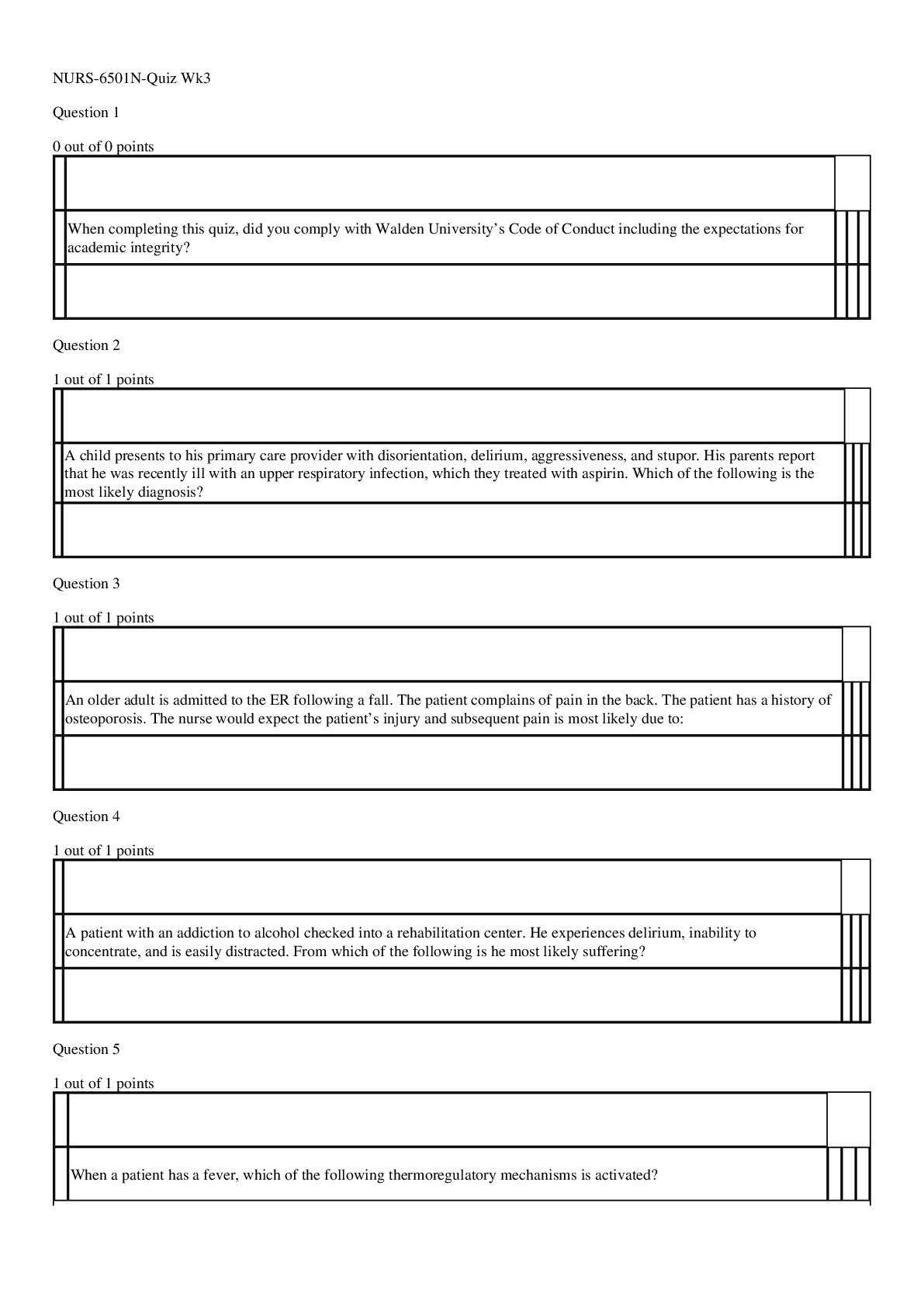
Reviews( 0 )
Document information
Connected school, study & course
About the document
Uploaded On
May 08, 2020
Number of pages
6
Written in
Additional information
This document has been written for:
Uploaded
May 08, 2020
Downloads
0
Views
34


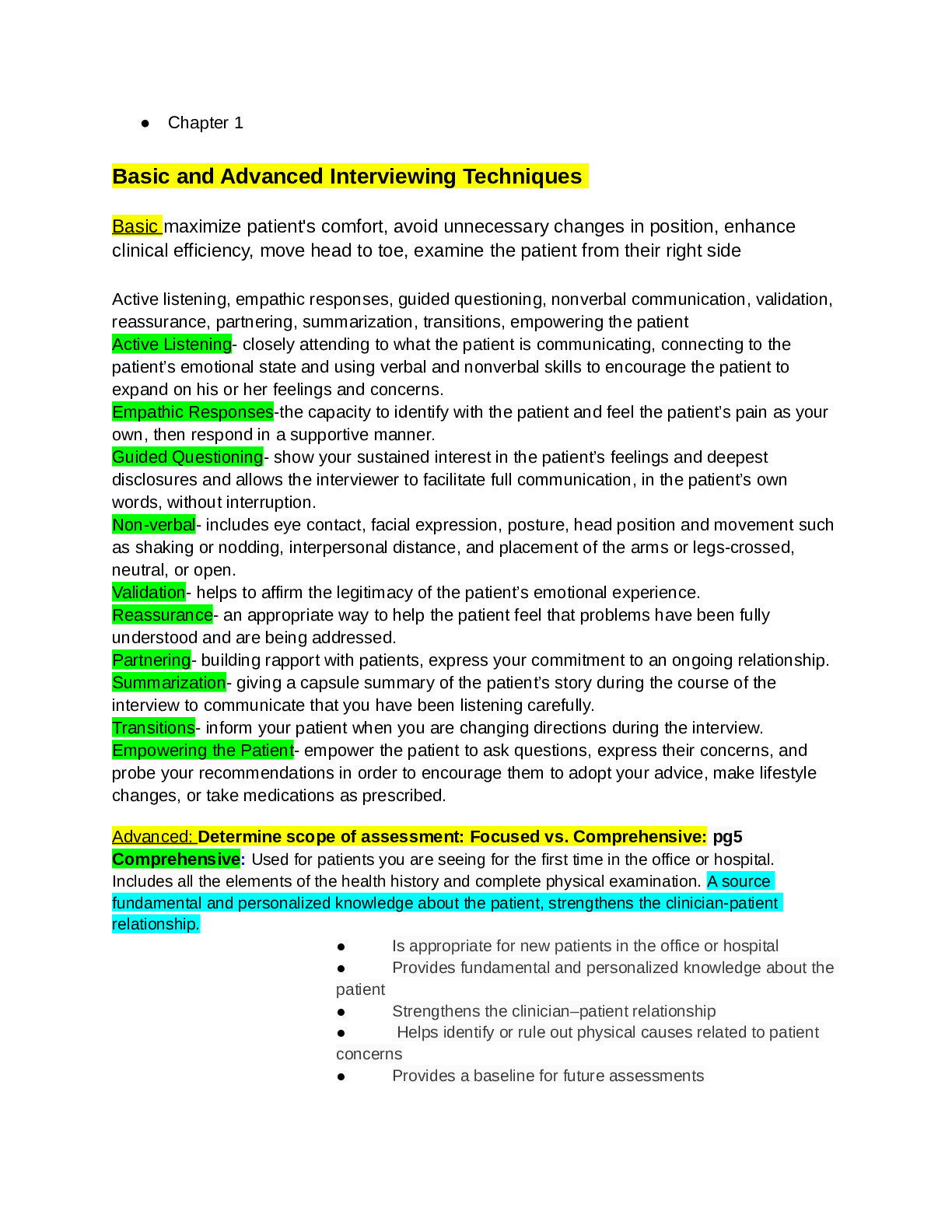
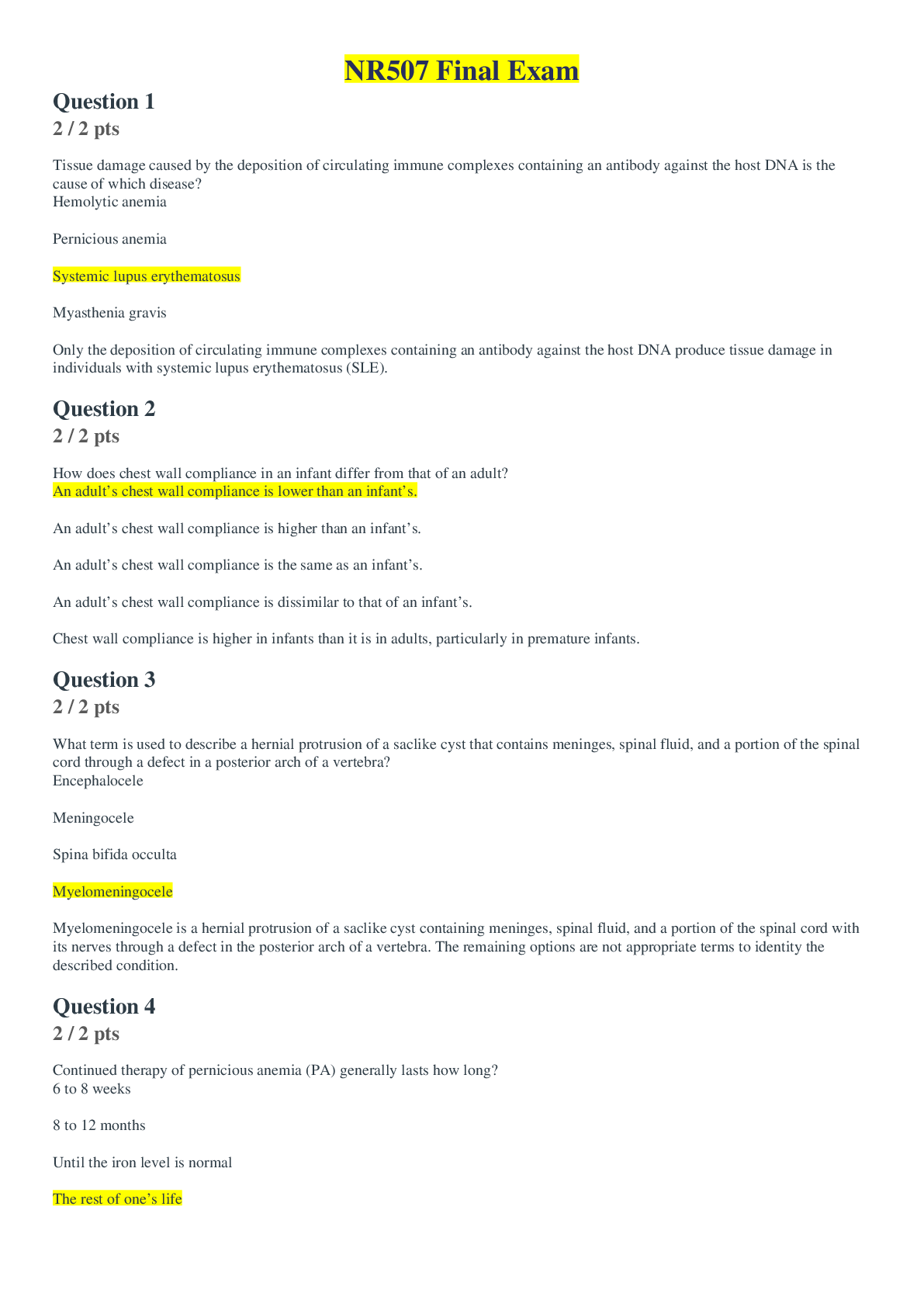

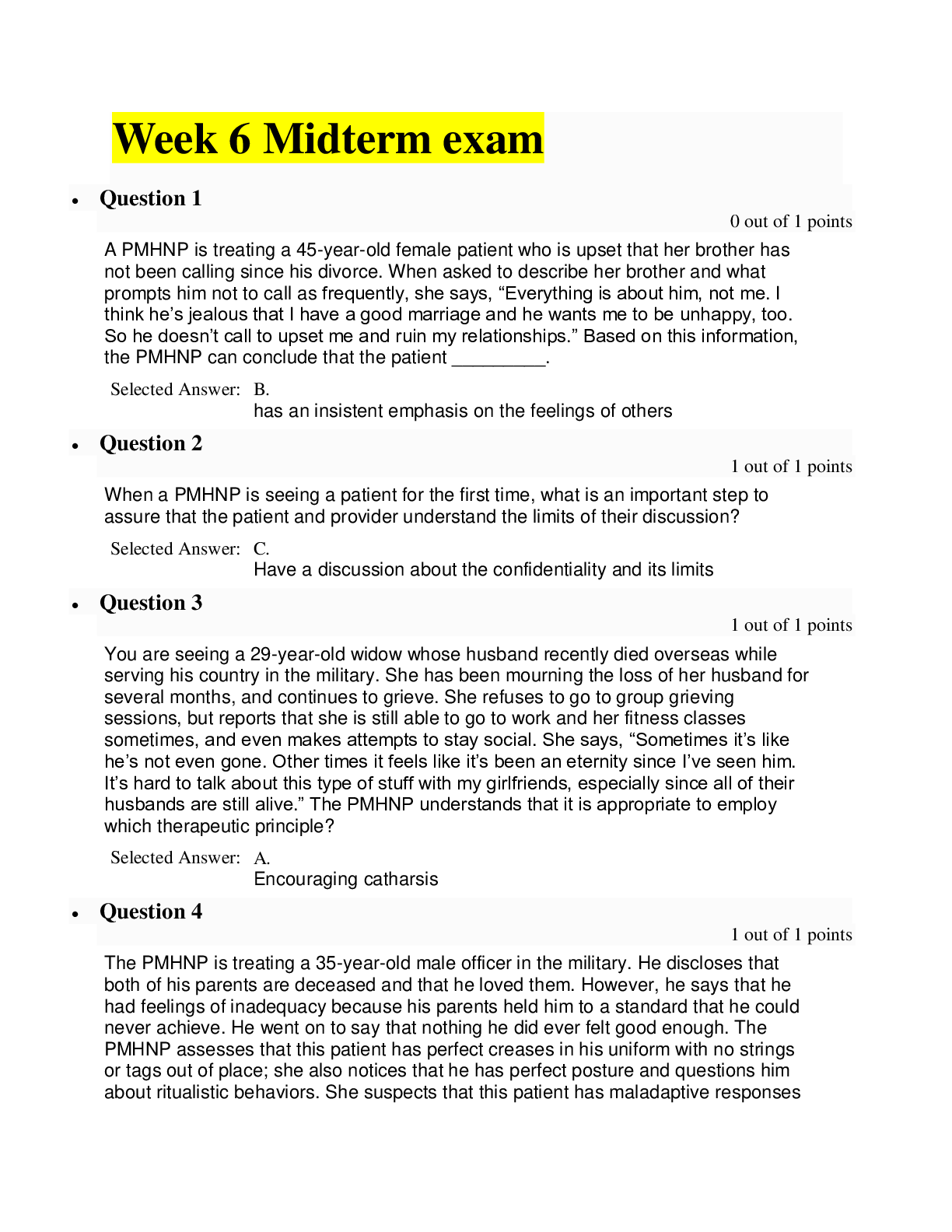

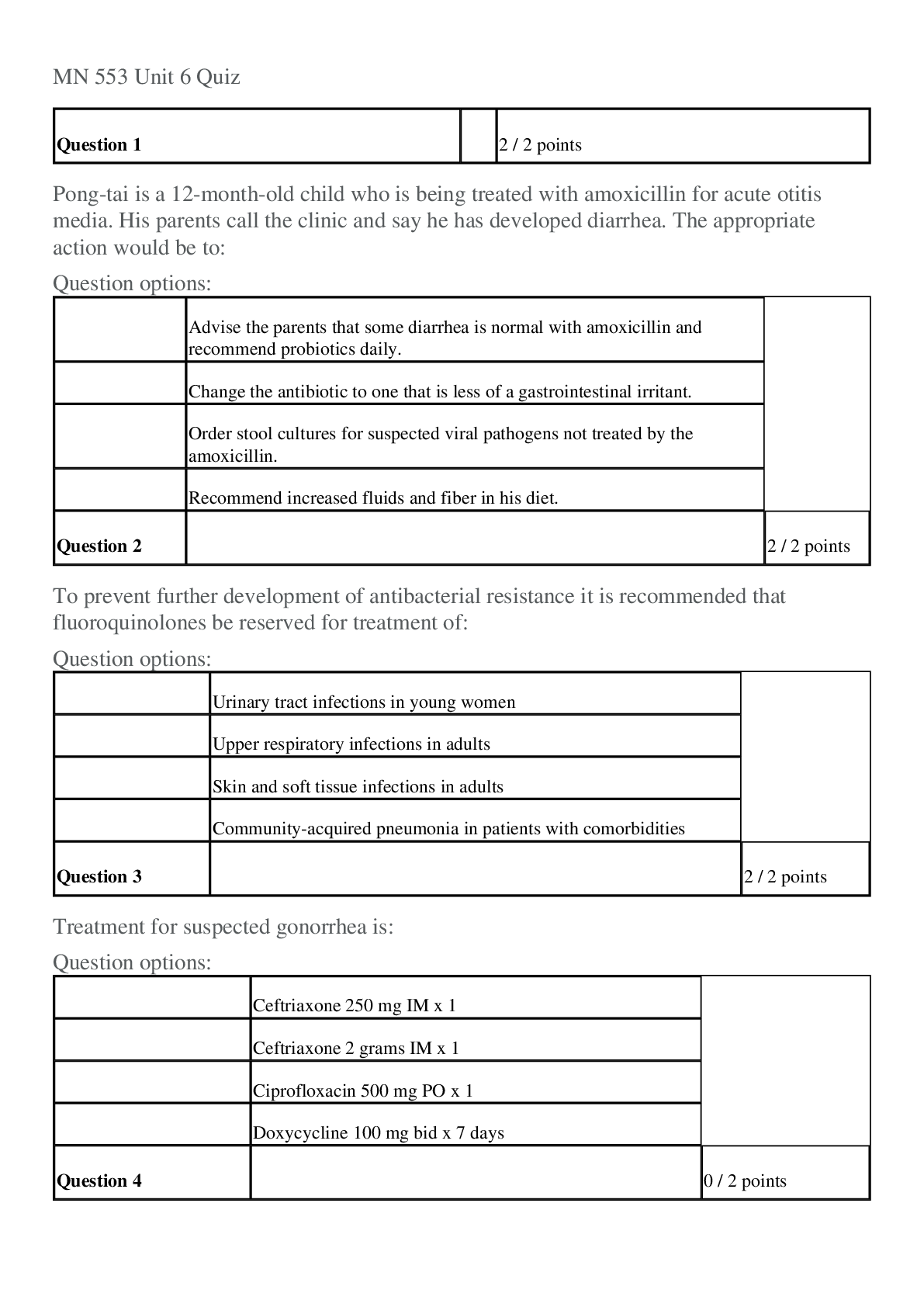


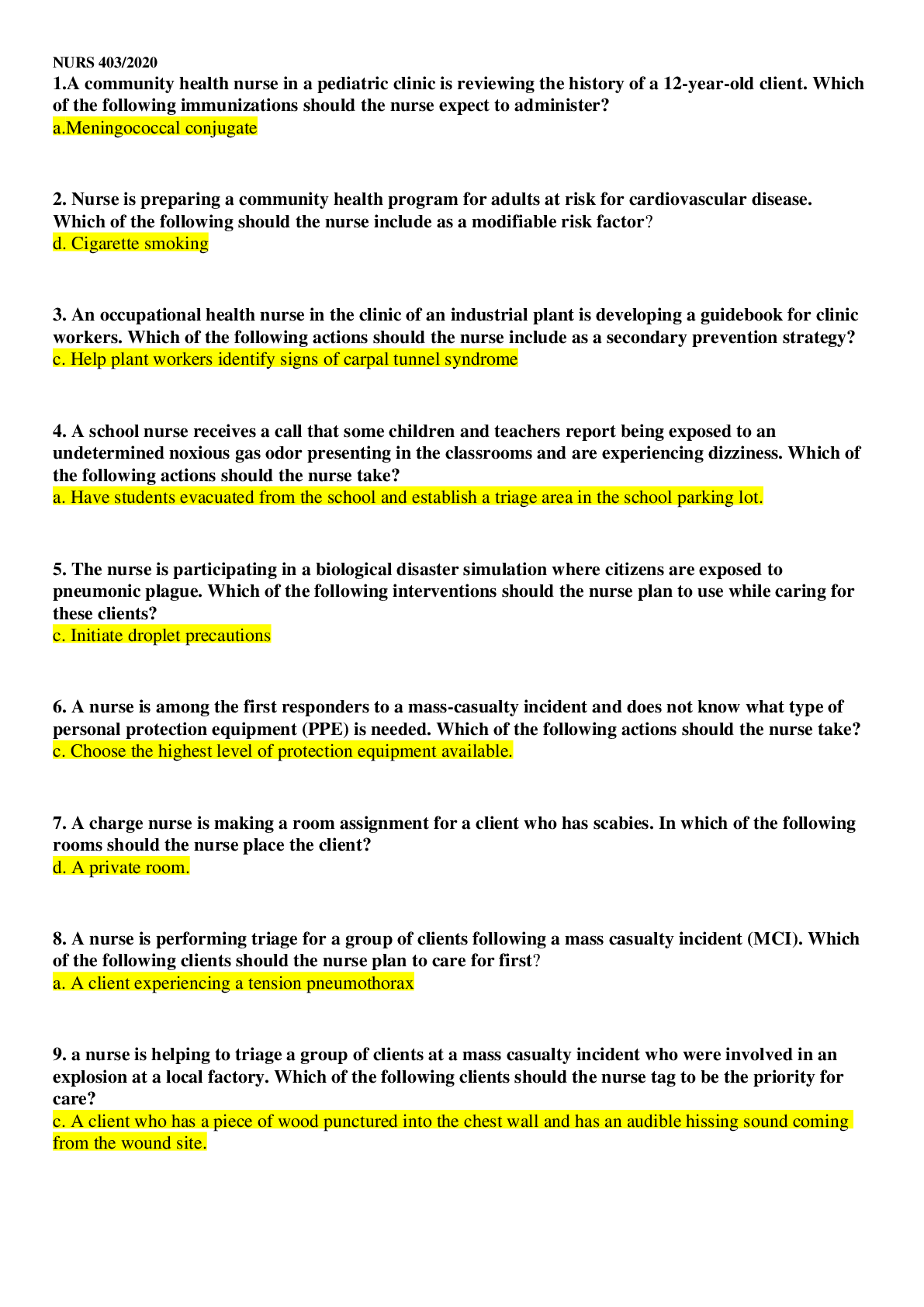

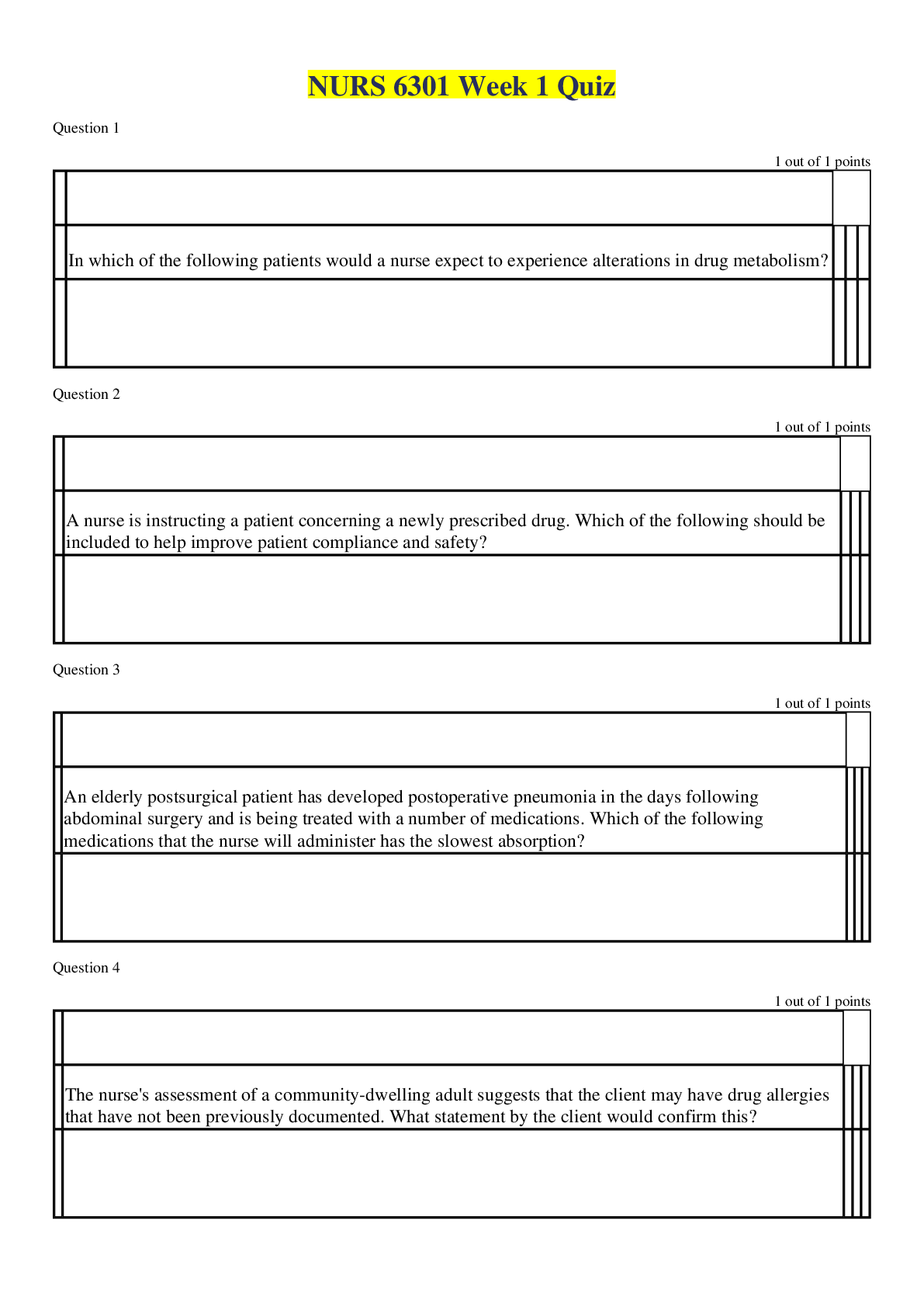
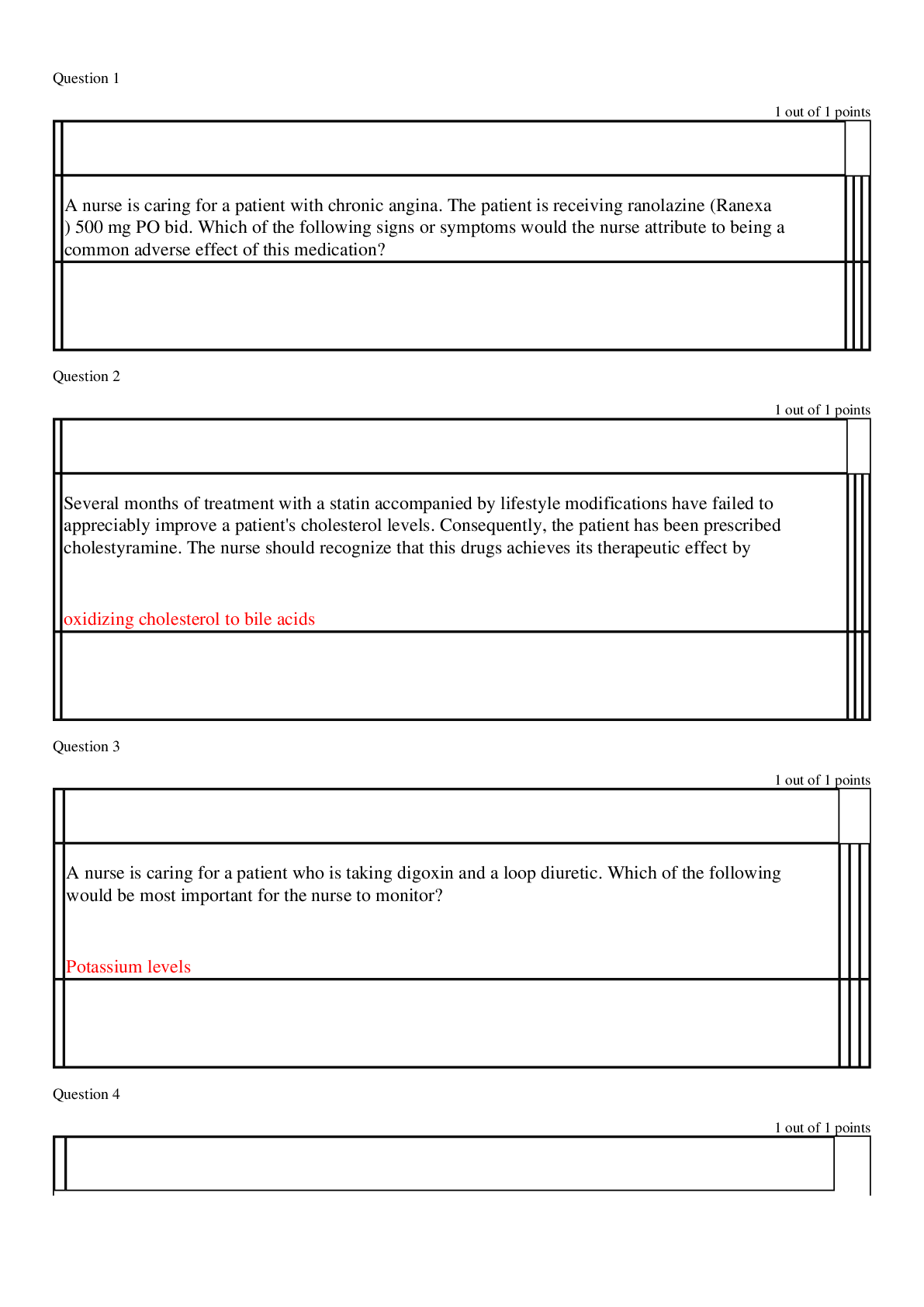

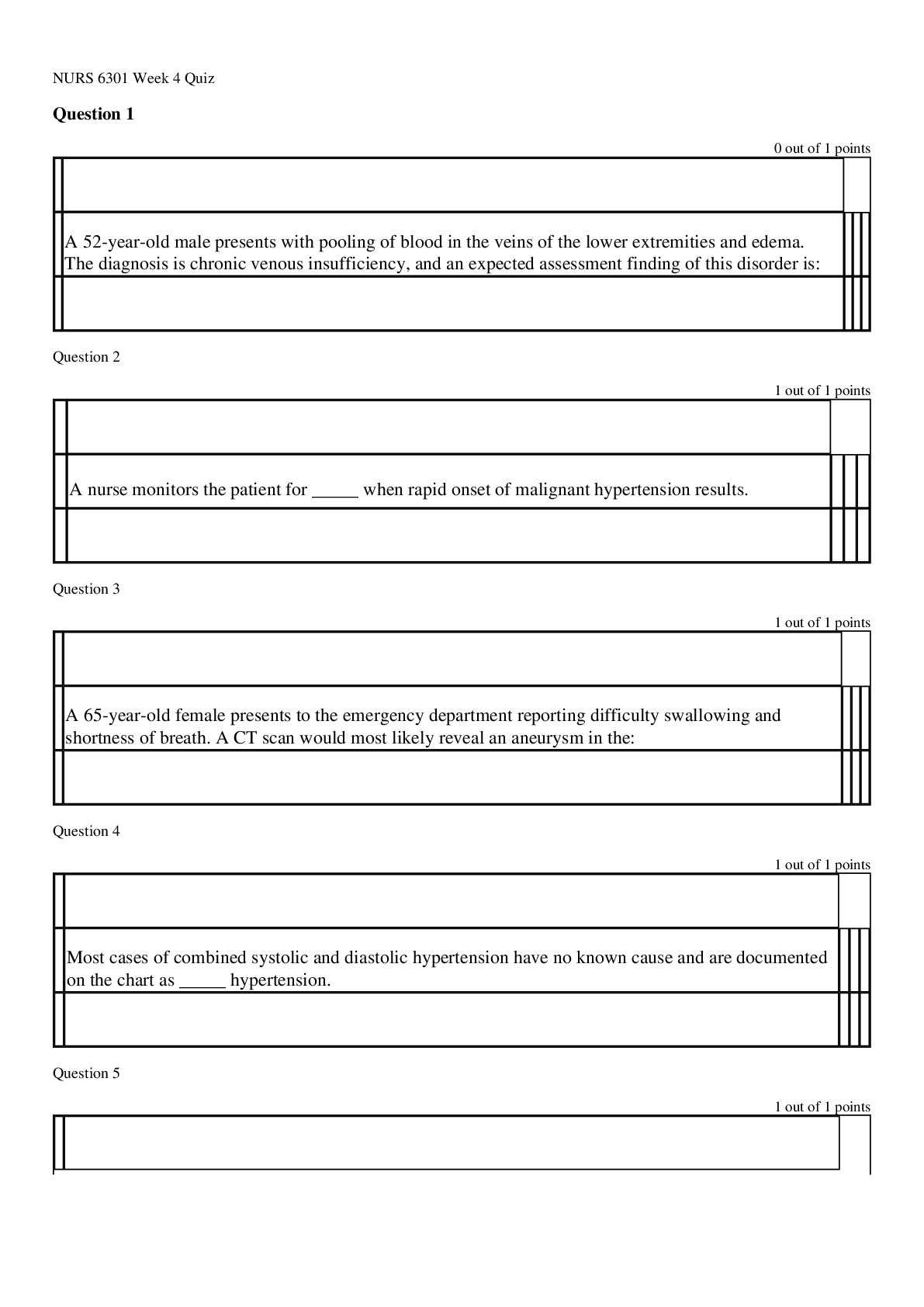

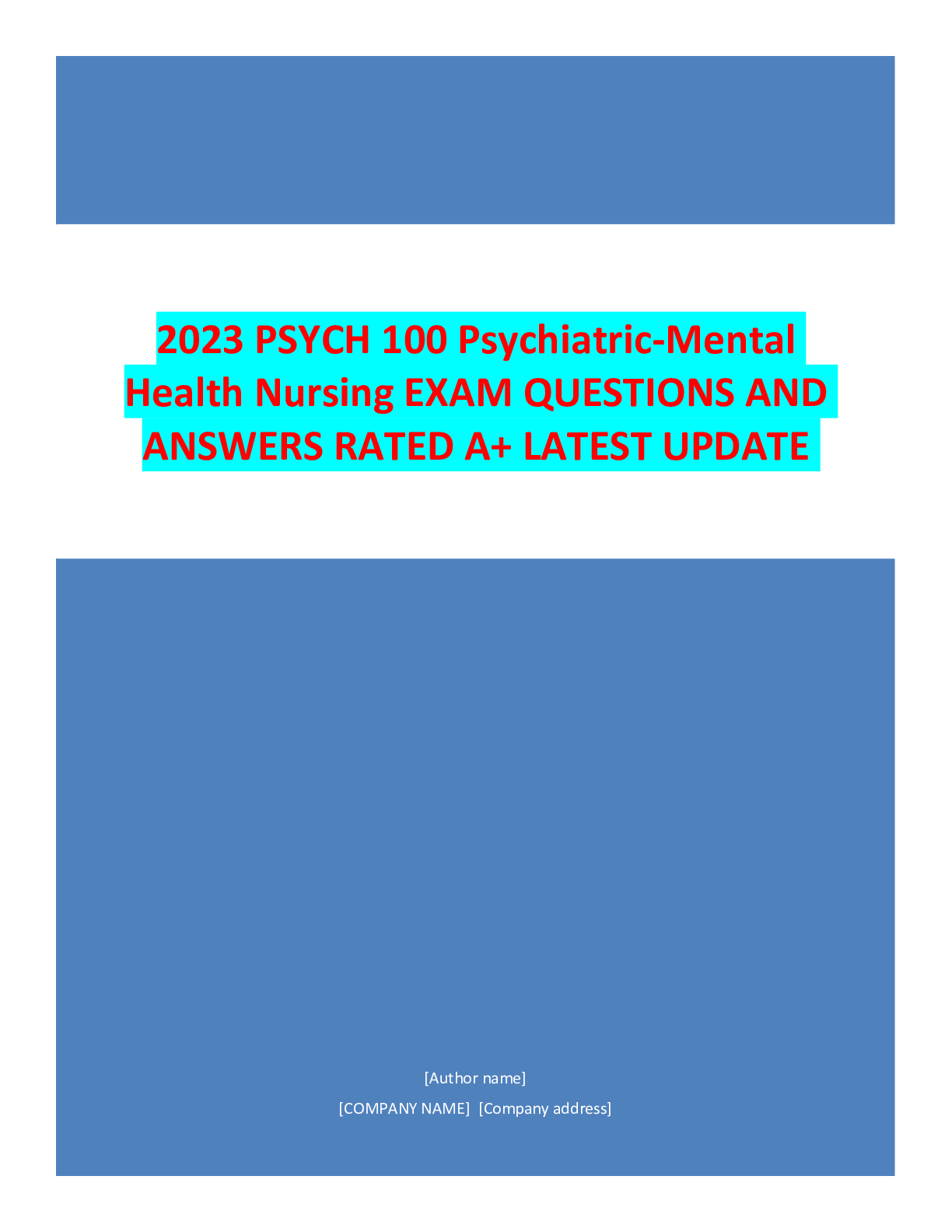
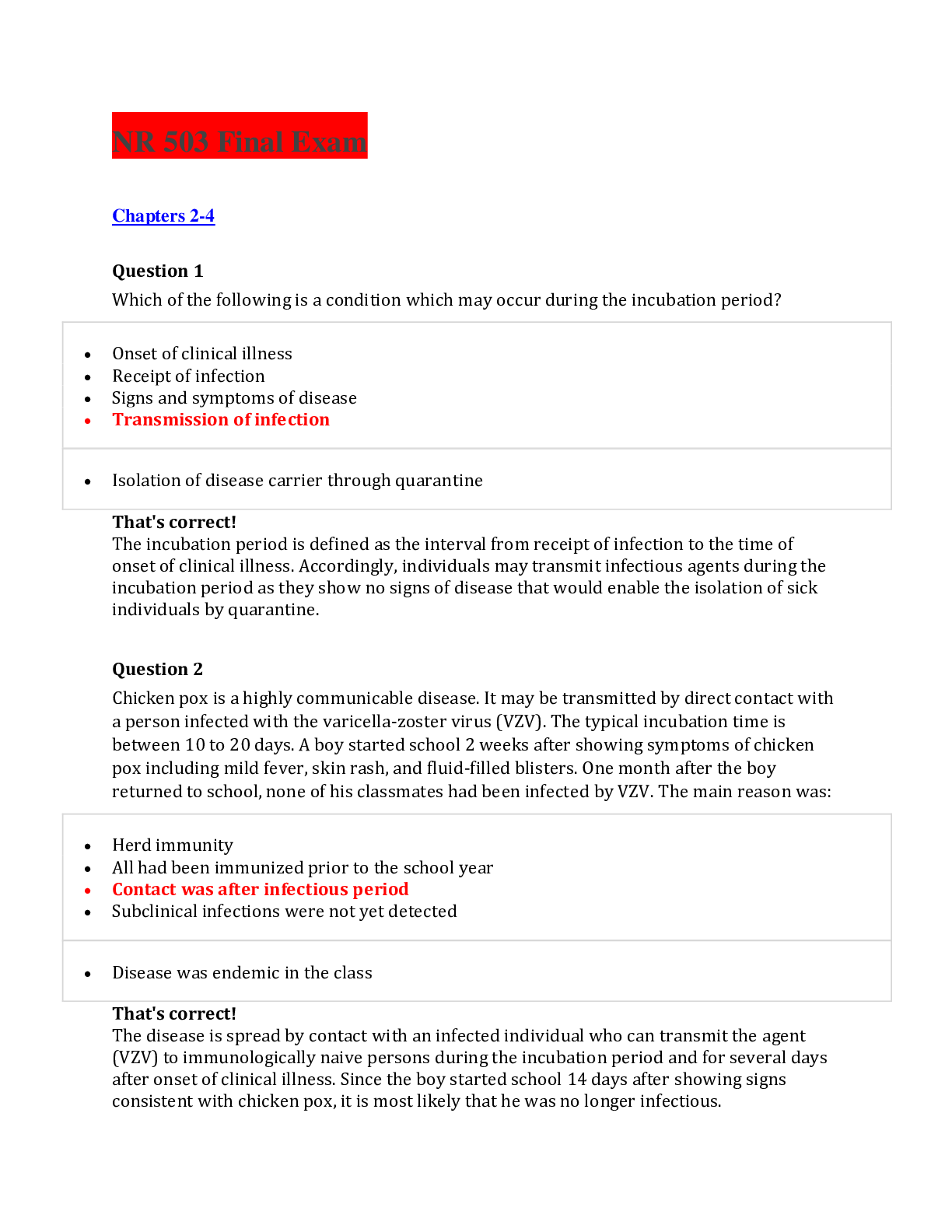

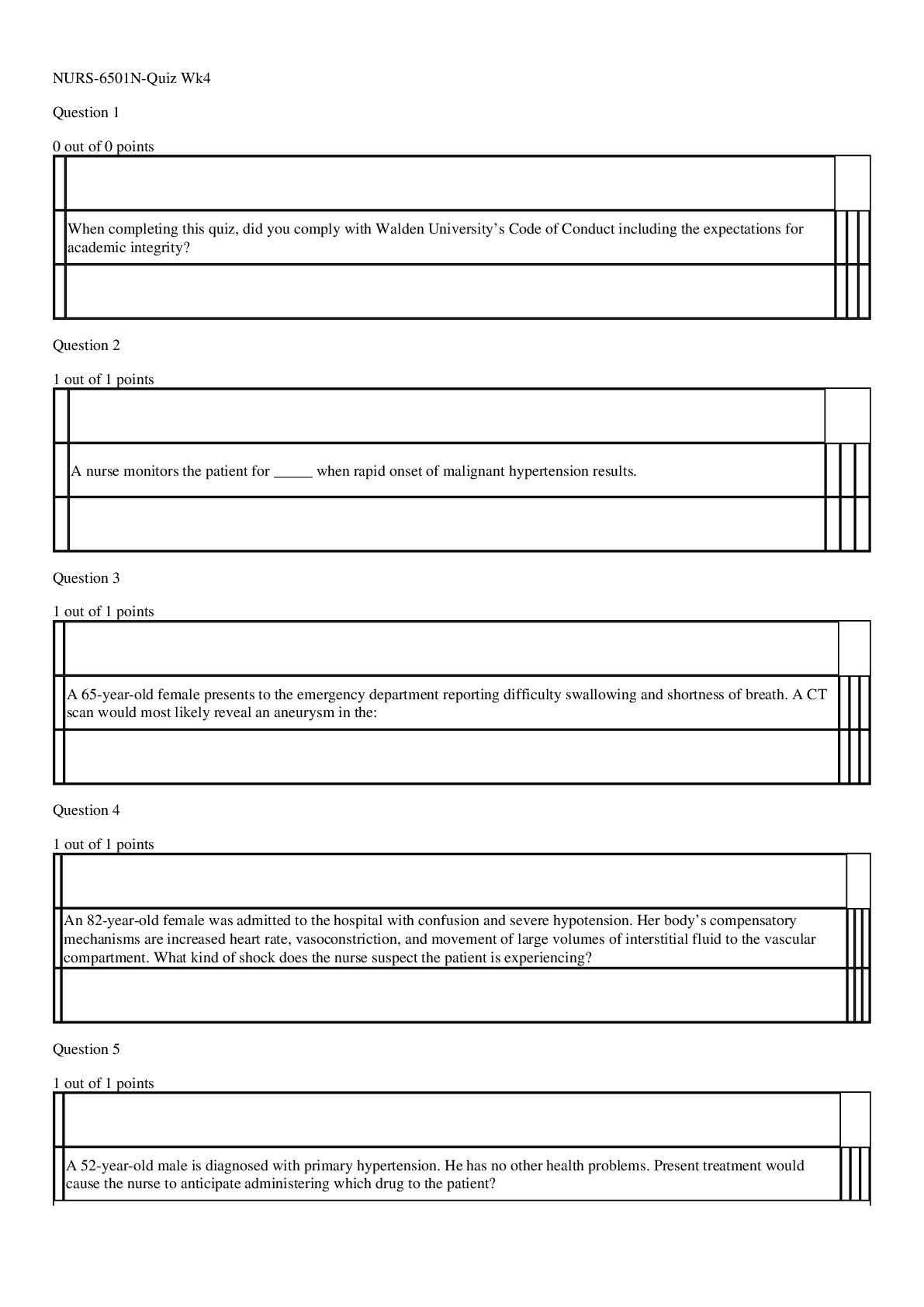
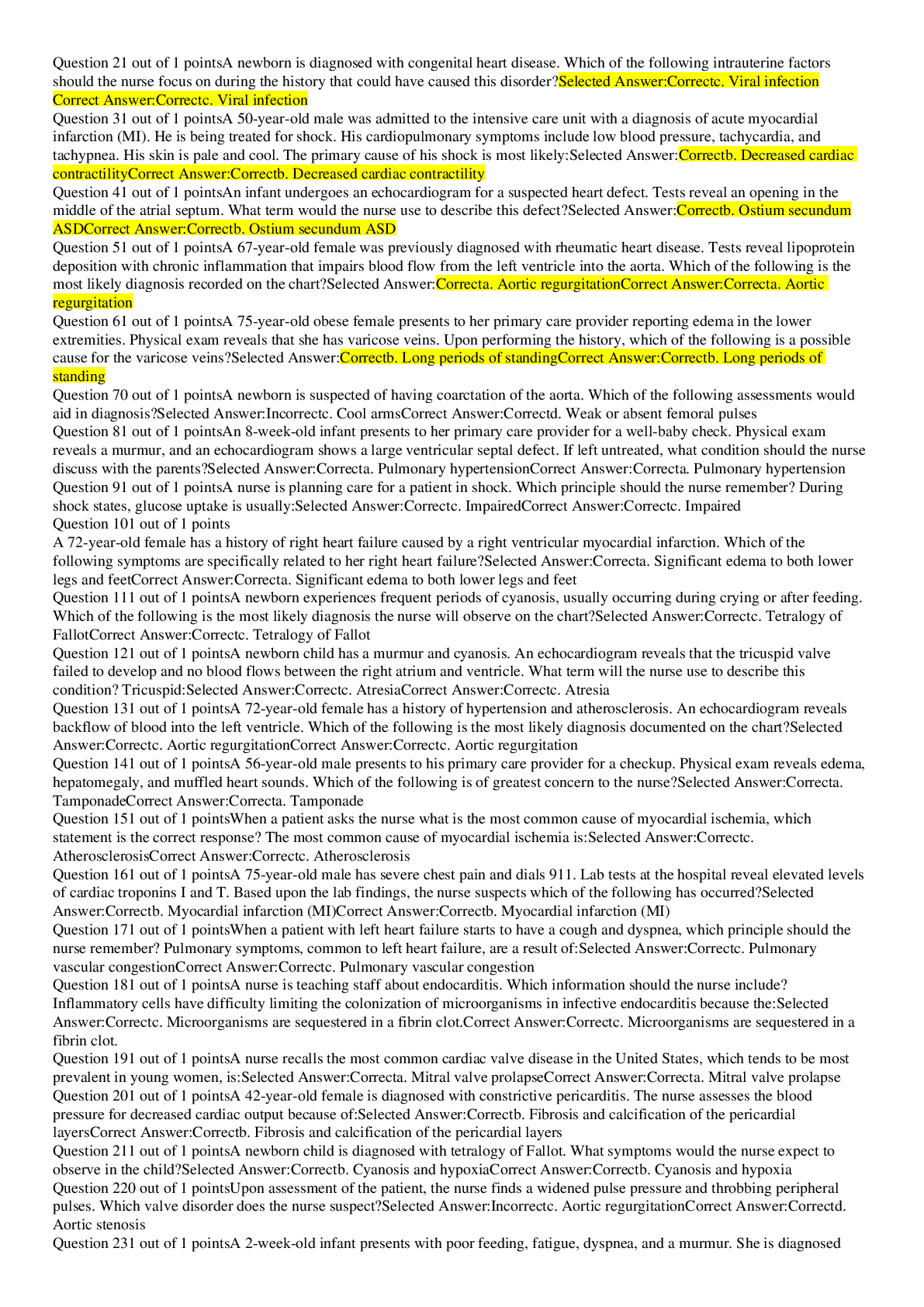
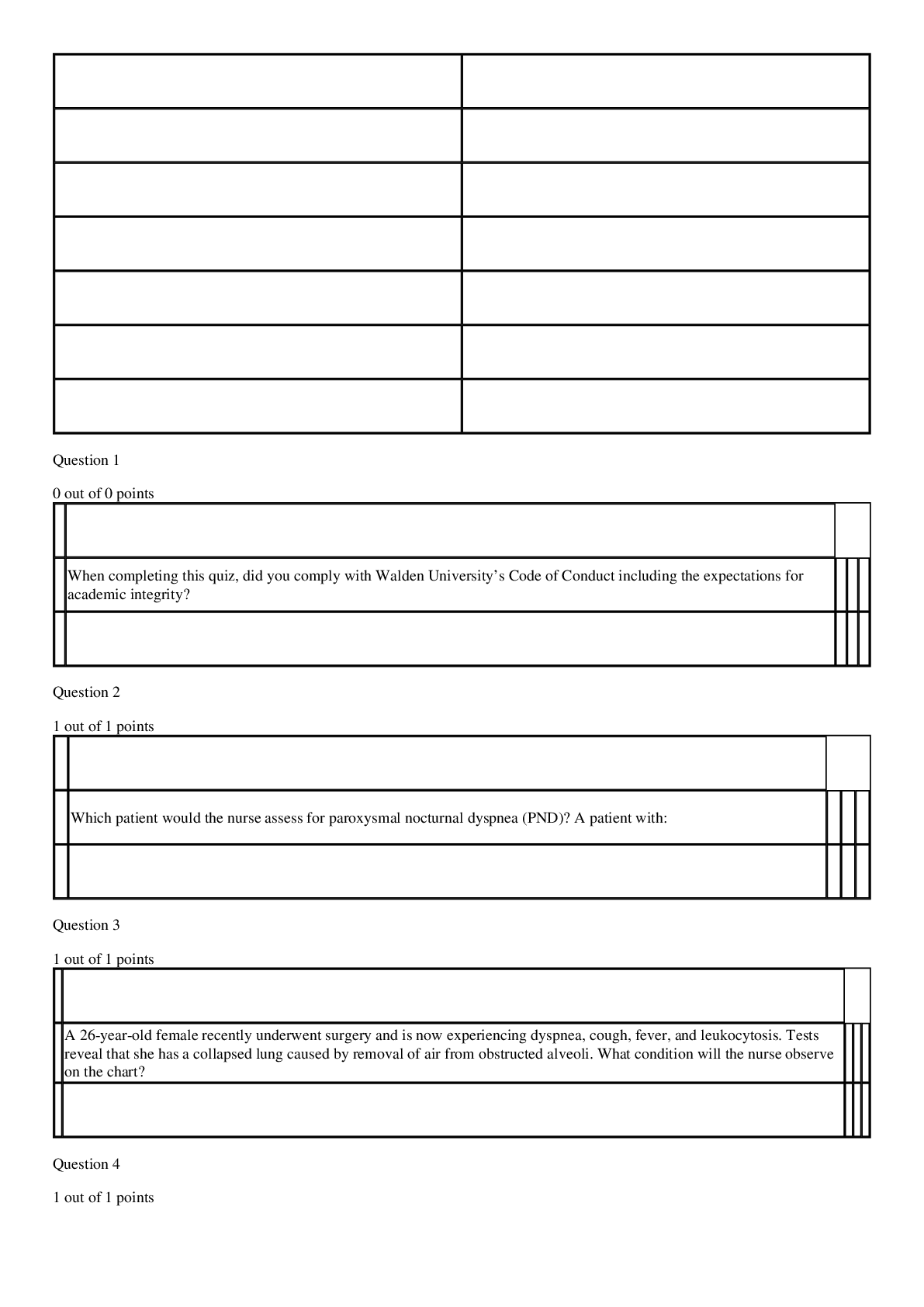
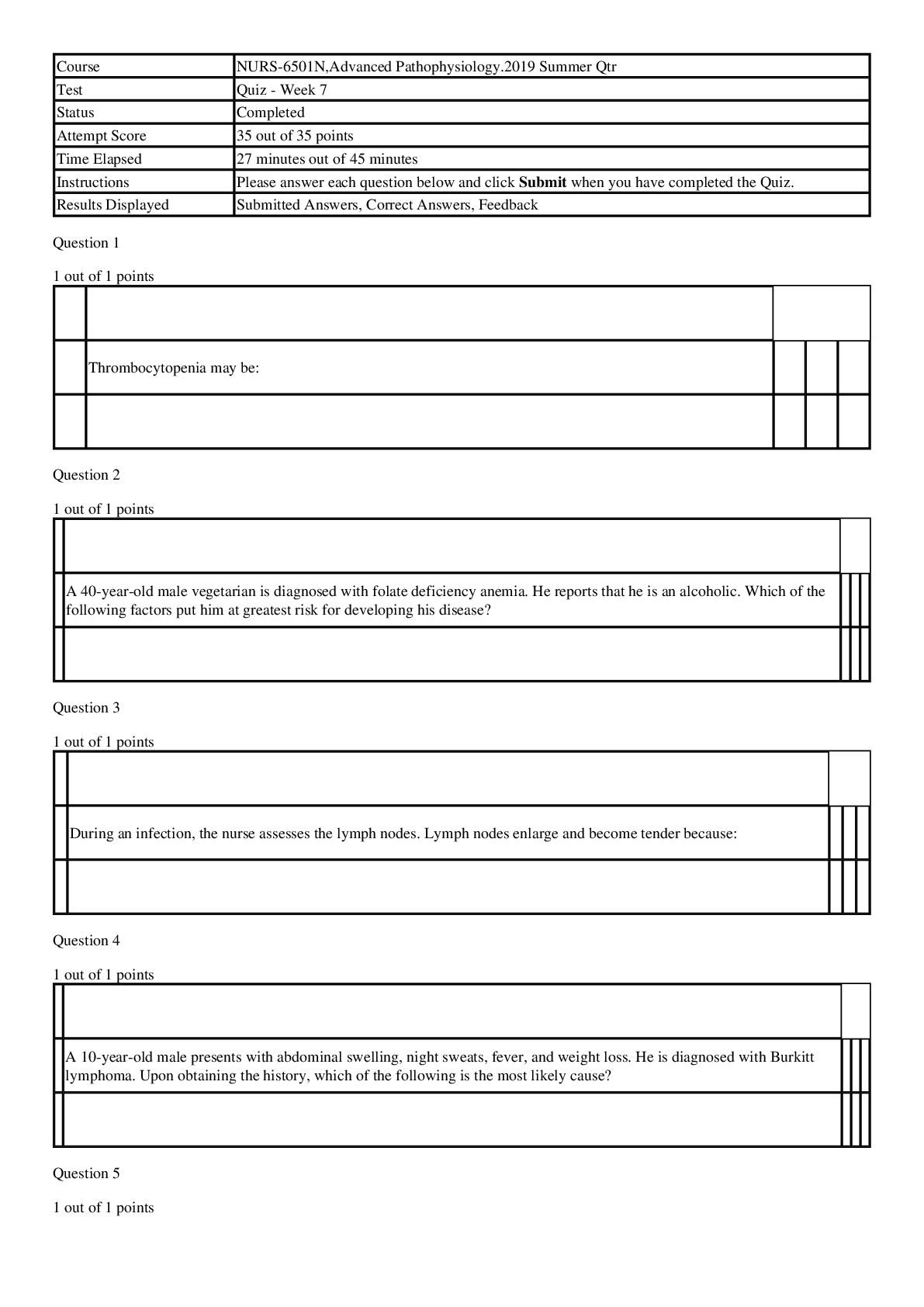
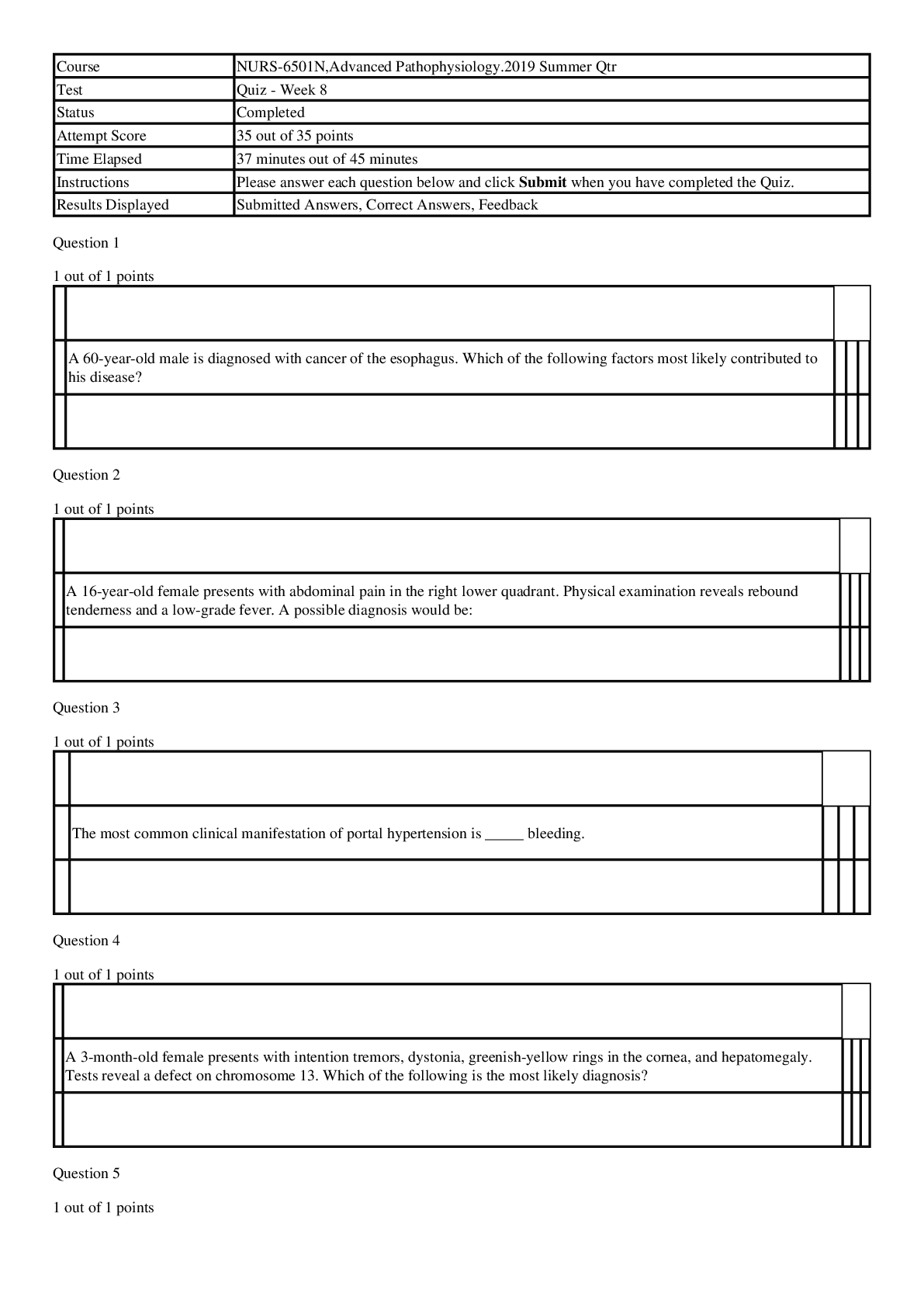



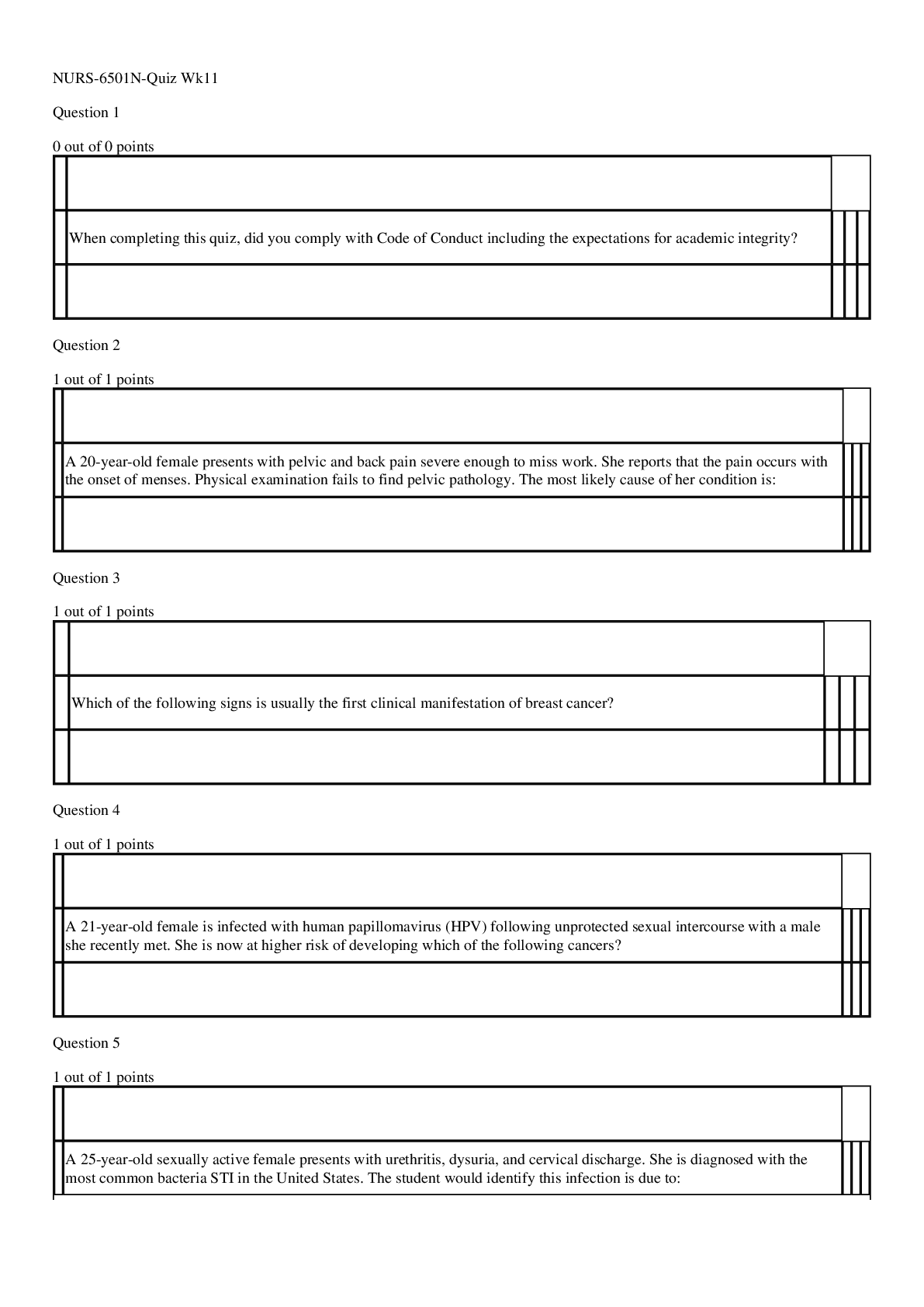
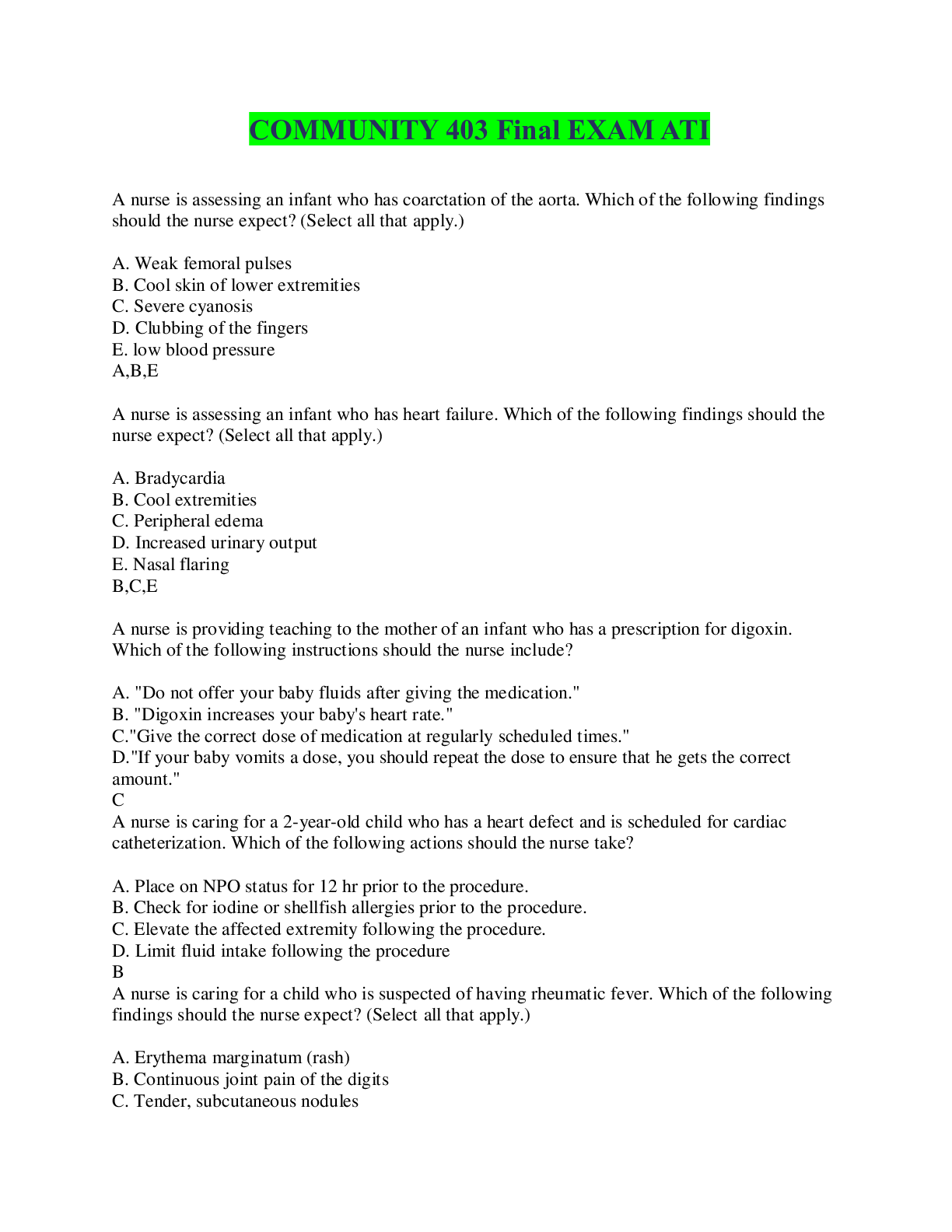
.png)
